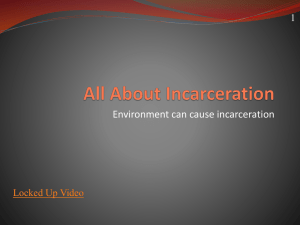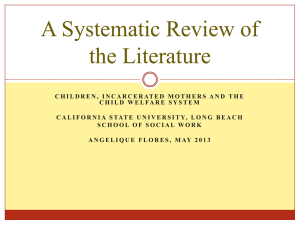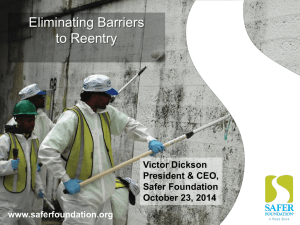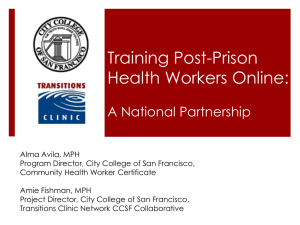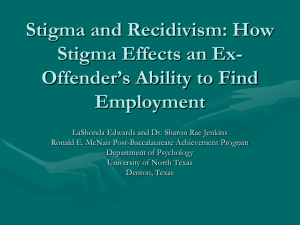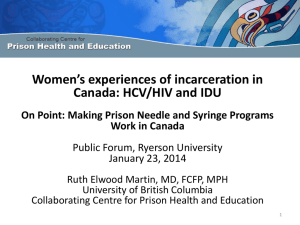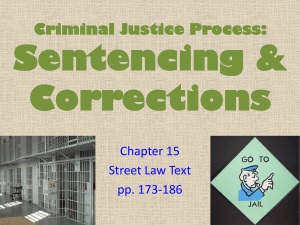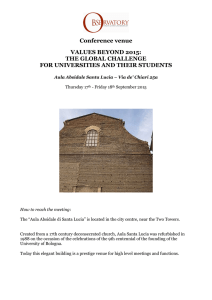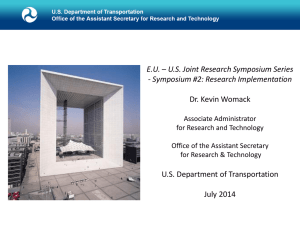Reentry Issues - County of Santa Clara
advertisement
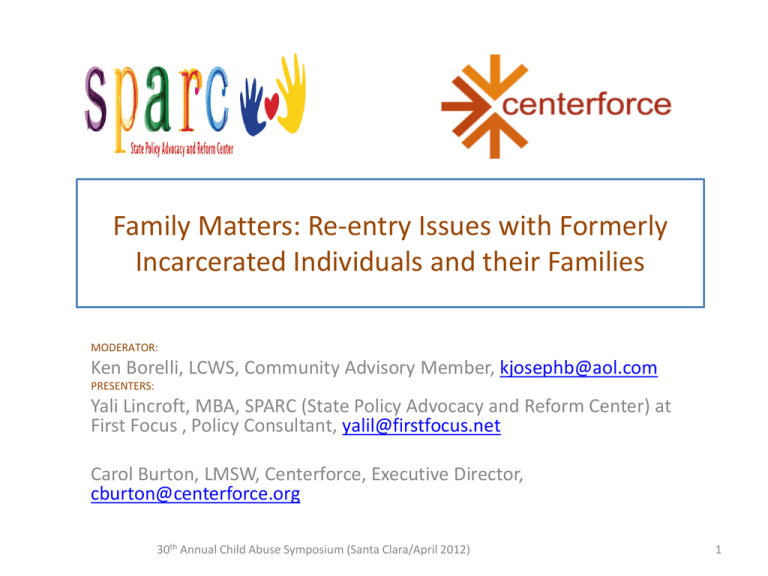
Family Matters: Re-entry Issues with Formerly Incarcerated Individuals and their Families MODERATOR: Ken Borelli, LCWS, Community Advisory Member, kjosephb@aol.com PRESENTERS: Yali Lincroft, MBA, SPARC (State Policy Advocacy and Reform Center) at First Focus , Policy Consultant, yalil@firstfocus.net Carol Burton, LMSW, Centerforce, Executive Director, cburton@centerforce.org 30th Annual Child Abuse Symposium (Santa Clara/April 2012) 1 Workshop Agenda • • • • • • Incarceration Facts & Figures An Overview of Realignment in California Common Myth Busters Partnership Examples Discussion/Q&A Resources and Additional Information 30th Annual Child Abuse Symposium (Santa Clara/April 2012) 2 Incarceration Facts and Figures 1 in 100 adults in America is in jail or prison. 1 in 31 adults in America are in jail, prison or on probation. Men are incarcerated at a rate 5x that of women Parental racial incarceration disparities: • 1 in 15 black children have a parent in prison • 1 in 41 Hispanic children have a parent in prison • 1 in 110 white children have a parent in prison 114% increase in the # women in state and federal prison (from 1990 to 2001) 30th Annual Child Abuse Symposium (Santa Clara/April 2012) 3 About Children of Incarcerated Parents During incarceration, parents primarily rely on their families for the care of their children. 90% of children with an incarcerated father live with their mothers. 50% of children with an incarcerated mother live with their grandmother. About 10-15% of the child welfare caseload involves an incarcerated parent. 30th Annual Child Abuse Symposium (Santa Clara/April 2012) 4 California’s Crisis: The Corrections System • Prison Overcrowding (175%) & Federal Receivership • Increase from 2% of General Fund 30 yrs ago to 5% 10 yrs ago to 10% in 2011 • May 23, 2011 Supreme Court decision ordered CA to reduce overcrowding by 30,000 inmates 30th Annual Child Abuse Symposium (Santa Clara/April 2012) 5 California’s Realignment Process “Re-alignment” is term created by Gov Brown’s plan to send those convicted of the three “non’s” to serve their sentence in county jails vs. state prisons (non-violent, nonserious, non-sexual) AB109 block grants distribute to the counties. Opportunity for partnerships between corrections/law enforcement with social services agencies like child welfare/health/housing. Each county is required to develop an AB109 plan and community advisory committee – re-entry councils have a critical role 30th Annual Child Abuse Symposium (Santa Clara/April 2012) 6 Reviewing the Corrections Systems from the Lens of a Child – A Bill of Rights for Children of Incarcerated Parents Arrest Jail Sentencing Prison Probation Court ordered drug treatment 30th Annual Child Abuse Symposium (Santa Clara/April 2012) Release CURB Report Card “CURB” (Californians United for a Responsible Budget) reviewed realignment plans for 13 counties FOUR Counties Pass (SF, Santa Cruz, Santa Clara and Alameda) – reduces jail population and provided programming and alternatives to incarceration TWO Counties Failed but with some improvements (Contra Costa and Sacramento) – are focused on expanding jail capacity but did invest in re-entry support and some alternatives to incarceration FIVE Counties Failed (SMateo, Riverside, SBernardino, SD, and LA) - are focusing on jail construction plans with little support for community alternatives to incarceration 30th Annual Child Abuse Symposium (Santa Clara/April 2012) 8 Common Myth Busters MYTH – People with criminal records are automatically barred from employment MYTH - Individuals who have been convicted of a crime are “banned” from public housing, can never receive SNAP, Social Security benefits and is not eligible to receive federal student financial aid MYTH – A parent with a felony conviction cannot receive TANF/welfare MYTH – Child welfare agencies are required to terminate parental rights if a parent is incarcerated. 30th Annual Child Abuse Symposium (Santa Clara/April 2012) 9 Partnership Ideas from Alameda Children of Incarcerated Partnership (ACCIP) • Centerforce/Alameda County Sheriff’s Department/Oakland Housing Authority Partnership with MOMS Program at Santa Rita County Jail • Oakland Children’s Hospital Early Childhood Mental Health Consultation • AB109 Policy Recommendations from ACCIPP • Data and Research with the National Council of Crime and Delinquency • Habbitot Children’s Museum 30th Annual Child Abuse Symposium (Santa Clara/April 2012) 10 Reforms at the San Francisco Department of Human Services • • • • • • Policy and Procedure Guideline (Section 57-8) Data collection in CMS/CWS Contract with nonprofit for visitation assistance in jail TDMs inside the jail Staff training Data sharing with the Sheriff’s Department and Probation Department • Federal grants include Second Chance Act and Court Improvement Funding 30th Annual Child Abuse Symposium (Santa Clara/April 2012) 11 San Francisco Human Services Agency Family and Children’s Services Handbook Effective Date: Revised Date: 10/1/08 HSA/FCS Policy Statement Date of Approval Debby Jeter Deputy Director, FCS Community Concerns Section 57-8 Arrested and Incarcerated Parents The following protocol is for Protective Services Workers (PSWs) communicating with and providing services to parents who are arrested and incarcerated. This policy is designed to provide Protective Services Workers with guidelines and procedures for providing appropriate services to arrested and incarcerated parents. An arrest of a parent in itself is not grounds for an allegation of child abuse or neglect. Incarceration of a parent may be an additional risk factor and, in all cases, decisions regarding an incarcerated parent should follow laws and Child Welfare regulations. The Human Services Agency (HSA), Family and Children’s Services (FCS) has contracted with a national organizational, Friends Outside, local chapter to provide services to incarcerated parents. Considerations for visits with Incarcerated parents Visitation must be provided to an incarcerated parent TABLE OF CONTENTS HSA/FCS Policy Statement Rights of Incarcerated Parents Arrest Protocol: Agreement between SFPD and FCS PSW Responsibilities Documentation CWS/CMS Locating and Noticing Incarcerated Parent Notice of Hearing Locating the Incarcerated Parent Friends Outside Program: Incarcerated Parent Liaison Resources and Links A Health Framework for Developing Programs for Families and Children of Incarcerated Parents (… a concept from Susan Phillips, Sentencing Project) An Example: Preventing the Flu Universal: teach everyone importance of hand washing and covering their mouth when they cough Selective: vaccinate vulnerable populations like the elderly and pregnant women Targeted: screen and treat individuals who show symptoms, such as fever and cough 30th Annual Child Abuse Symposium (Santa Clara/April 2012) 14 What Works … • Program which offer a variety of services and works with the parent, the caregiver and the child at the same time • Programs which offer TA like legal services, child support, benefits programs, housing, etc. • Programs which include clients as staff and advisory members • Programs which are non-judgmental, offers a holistic • Programs which uses the “crisis opportunity” for quality parent/child interaction and wrapping services both inside/outside the corrections setting FOR CHILD WELFARE CASES: Specialized social workers focused on maintaining contacts and visits, potential relative placement, as well as subcontract with agencies who are familiar with corrections. 15 What Doesn’t Works • Stigma, Judgment, and Social Isolation • Impossible hurdles • Distinguishing between the children and the parents in policy and practice • Zero tolerance of children in school • Demonizing the parent and pretending that the kids do not need their justice involved parent • Corrections (and social service staff) not understanding an appropriate child response to a reunifying parents 16 Why we do this work… “I was serving time with a woman who had only 10 years to do. Twenty years later, some kid comes up to me and says, “Aren’t you Ms. Mechie? My mom told me to look you up when I got here.” At first I was glad to see someone else’s child, like they dropped by my house to visit. Then it occurred to me just how tragic a scene this is. Now it happens all the time – I’m forever looking out for somebody’s kid here in prison. I see three generations of mothers, all in prison at once. For those who lack clear evidence of intergenerational incarceration – here we all are!” -- MARIE SCOTT SOURCE: Howard Zehr and Lorraine Stutzman Amstutz, “What Will Happen to Me?” (2010), available at www.GoodBooks.com or Amazon.com 17 Resources & Additional Information Yali Lincroft and Ken Borelli (2011). When a Parent is Incarcerated: A Primer for Social Workers. Annie E. Casey Foundation, see www.aecf.org website The National Resource Center on Children and Families of the Incarcerated (Family and Corrections Network) http://fcnetwork.org/ National Re entry Resource Center – webinars on re-entry issues and working with families, http://www.nationalreentryresourcecenter.org/ • How & Why Probation Dept Should Partner with Families • From Arrest to Homecoming – Addressing the Needs of Children of Incarcerated Parents 18 Resources & Additional Information Northern California Training Academy (Spring 2008). Out of the Shadows: What Child Welfare Workers Can Do to Help Children and their Incarcerated Parents. UC Davis: The Center for Human Services. http://humanservices.ucdavis.edu/news/pdf/074_140.pdf KARE Family Center (2011). Behind Bars- Difficult Questions Children Ask … And Answers That Might Help. Arizona children’s Association. http://www.arizonaschildren.org/documents/AZFamily MembersBehindBarsFinal.pdf Zehr, H., Amstutz, LS (2011). What Will Happen to Me? Good Books, PA. RISE – By and For Parents in the Child Welfare System (Summer 2008). Parenting from Prison (issue NO. 10). Youth Communications. http://www.risemagazine.org National CASA Conference (Washington DC June 2012) 19
